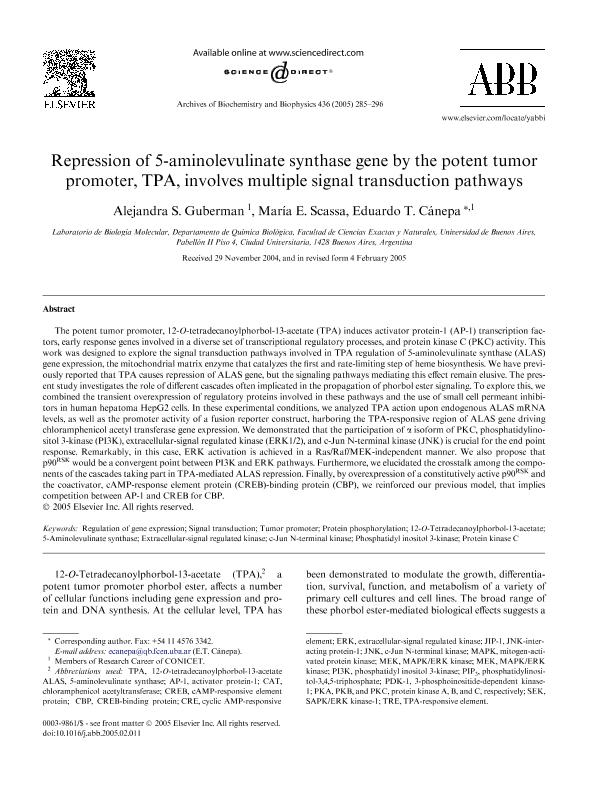Mostrar el registro sencillo del ítem
dc.contributor.author
Guberman, Alejandra Sonia

dc.contributor.author
Scassa, Maria Elida

dc.contributor.author
Canepa, Eduardo Tomas

dc.date.available
2020-03-11T18:31:45Z
dc.date.issued
2005-04
dc.identifier.citation
Guberman, Alejandra Sonia; Scassa, Maria Elida; Canepa, Eduardo Tomas; Repression of 5-aminolevulinate synthase gene by the potent tumor promoter, TPA, involves multiple signal transduction pathways; Elsevier Science Inc; Archives of Biochemistry and Biophysics; 436; 2; 4-2005; 285-296
dc.identifier.issn
0003-9861
dc.identifier.uri
http://hdl.handle.net/11336/99172
dc.description.abstract
The potent tumor promoter, 12-O-tetradecanoylphorbol-13-acetate (TPA) induces activator protein-1 (AP-1) transcription factors, early response genes involved in a diverse set of transcriptional regulatory processes, and protein kinase C (PKC) activity. This work was designed to explore the signal transduction pathways involved in TPA regulation of 5-aminolevulinate synthase (ALAS) gene expression, the mitochondrial matrix enzyme that catalyzes the first and rate-limiting step of heme biosynthesis. We have previously reported that TPA causes repression of ALAS gene, but the signaling pathways mediating this effect remain elusive. The present study investigates the role of different cascades often implicated in the propagation of phorbol ester signaling. To explore this, we combined the transient overexpression of regulatory proteins involved in these pathways and the use of small cell permeant inhibitors in human hepatoma HepG2 cells. In these experimental conditions, we analyzed TPA action upon endogenous ALAS mRNA levels, as well as the promoter activity of a fusion reporter construct, harboring the TPA-responsive region of ALAS gene driving chloramphenicol acetyl transferase gene expression. We demonstrated that the participation of α isoform of PKC, phosphatidylinositol 3-kinase (PI3K), extracellular-signal regulated kinase (ERK1/2), and c-Jun N-terminal kinase (JNK) is crucial for the end point response. Remarkably, in this case, ERK activation is achieved in a Ras/Raf/MEK-independent manner. We also propose that p90RSK would be a convergent point between PI3K and ERK pathways. Furthermore, we elucidated the crosstalk among the components of the cascades taking part in TPA-mediated ALAS repression. Finally, by overexpression of a constitutively active p90RSK and the coactivator, cAMP-response element protein (CREB)-binding protein (CBP), we reinforced our previous model, that implies competition between AP-1 and CREB for CBP.
dc.format
application/pdf
dc.language.iso
eng
dc.publisher
Elsevier Science Inc

dc.rights
info:eu-repo/semantics/openAccess
dc.rights.uri
https://creativecommons.org/licenses/by-nc-sa/2.5/ar/
dc.subject
12-O-TETRADECANOYLPHORBOL-13-ACETATE
dc.subject
5-AMINOLEVULINATE SYNTHASE
dc.subject
C-JUN N-TERMINAL KINASE
dc.subject
EXTRACELLULAR-SIGNAL REGULATED KINASE
dc.subject
PHOSPHATIDYL INOSITOL 3-KINASE
dc.subject
PROTEIN PHOSPHORYLATION
dc.subject
REGULATION OF GENE EXPRESSION
dc.subject
SIGNAL TRANSDUCTION
dc.subject
TUMOR PROMOTER
dc.subject.classification
Genética y Herencia

dc.subject.classification
Ciencias Biológicas

dc.subject.classification
CIENCIAS NATURALES Y EXACTAS

dc.title
Repression of 5-aminolevulinate synthase gene by the potent tumor promoter, TPA, involves multiple signal transduction pathways
dc.type
info:eu-repo/semantics/article
dc.type
info:ar-repo/semantics/artículo
dc.type
info:eu-repo/semantics/publishedVersion
dc.date.updated
2020-02-13T20:04:30Z
dc.journal.volume
436
dc.journal.number
2
dc.journal.pagination
285-296
dc.journal.pais
Países Bajos

dc.journal.ciudad
Amsterdam
dc.description.fil
Fil: Guberman, Alejandra Sonia. Universidad de Buenos Aires. Facultad de Ciencias Exactas y Naturales. Departamento de Química Biológica. Laboratorio de Biología Molecular; Argentina. Consejo Nacional de Investigaciones Científicas y Técnicas; Argentina
dc.description.fil
Fil: Scassa, Maria Elida. Consejo Nacional de Investigaciones Científicas y Técnicas; Argentina. Universidad de Buenos Aires. Facultad de Ciencias Exactas y Naturales. Departamento de Química Biológica. Laboratorio de Biología Molecular; Argentina
dc.description.fil
Fil: Canepa, Eduardo Tomas. Universidad de Buenos Aires. Facultad de Ciencias Exactas y Naturales. Departamento de Química Biológica. Laboratorio de Biología Molecular; Argentina. Consejo Nacional de Investigaciones Científicas y Técnicas; Argentina
dc.journal.title
Archives of Biochemistry and Biophysics

dc.relation.alternativeid
info:eu-repo/semantics/altIdentifier/url/https://www.sciencedirect.com/science/article/pii/S0003986105000652
dc.relation.alternativeid
info:eu-repo/semantics/altIdentifier/doi/http://dx.doi.org/10.1016/j.abb.2005.02.011
Archivos asociados
